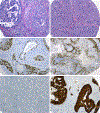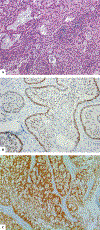RETRACTED ARTICLE: Cervical adenosquamous carcinoma: detailed analysis of morphology, immunohistochemical profile, and clinical outcomes in 59 cases
- PMID: 30258209
- PMCID: PMC6353675
- DOI: 10.1038/s41379-018-0123-6
RETRACTED ARTICLE: Cervical adenosquamous carcinoma: detailed analysis of morphology, immunohistochemical profile, and clinical outcomes in 59 cases
Retraction in
-
Retraction Note to: Cervical adenosquamous carcinoma: detailed analysis of morphology, immunohistochemical profile, and clinical outcomes in 59 cases.Mod Pathol. 2022 Jun;35(6):854. doi: 10.1038/s41379-022-01072-0. Mod Pathol. 2022. PMID: 35338261 Free PMC article. No abstract available.
Abstract
Although 2014 World Health Organization criteria require unequivocal glandular and squamous differentiation for a diagnosis of cervical adenosquamous carcinoma, in practice, adenosquamous carcinoma diagnoses are often made in tumors that lack unequivocal squamous and/or glandular differentiation. Considering the ambiguous etiologic, morphological, and clinical features and outcomes associated with adenosquamous carcinomas, we sought to redefine these tumors. We reviewed slides from 59 initially diagnosed adenosquamous carcinomas (including glassy cell carcinoma and related lesions) to confirm an adenosquamous carcinoma diagnosis only in the presence of unequivocal malignant glandular and squamous differentiation. Select cases underwent immunohistochemical profiling as well as human papillomavirus (HPV) testing by in situ hybridization. Of the 59 cases originally classified as adenosquamous carcinomas, 34 retained their adenosquamous carcinoma diagnosis, 9 were reclassified as pure invasive stratified mucin-producing carcinomas, 10 as invasive stratified mucin-producing carcinomas with other components (such as HPV-associated mucinous, usual-type, or adenosquamous carcinomas), and 4 as HPV-associated usual or mucinous adenocarcinomas with benign-appearing squamous metaplasia. Two glassy cell carcinomas were reclassified as poorly differentiated usual-type carcinomas based on morphology and immunophenotype. There were significant immunophenotypic differences between adenosquamous carcinomas and pure invasive stratified mucin-producing carcinomas with regard to HPV (p < 0.0001), PAX8 (p = 0.038; more in adenosquamous carcinoma), p40 (p < 0.0001; more in adenosquamous carcinoma), p63 (p = 0.0018; more in adenosquamous carcinoma) and MUC6 (p < 0.0001; less in adenosquamous carcinoma), HNF-1beta (p = 0.0023), vimentin (p = 0.0003), p53 (p = 0.0004), and CK7 (p = 0.0002) expression. Survival outcomes were similar between all groups. Adenosquamous carcinomas should be diagnosed only in the presence of unequivocal malignant glandular and squamous differentiation. The two putative glassy cell carcinomas studied did not meet our criteria for adenosquamous carcinoma, and categorizing them as such should be reconsidered.
Conflict of interest statement
Figures








Similar articles
-
Cervical Adenosquamous Carcinoma: Detailed Analysis of Morphology, Immunohistochemical Profile, and Outcome in 59 Cases.Int J Gynecol Pathol. 2023 May 1;42(3):259-269. doi: 10.1097/PGP.0000000000000921. Epub 2022 Aug 31. Int J Gynecol Pathol. 2023. PMID: 36044310 Free PMC article. Review.
-
Diagnostic Algorithmic Proposal Based on Comprehensive Immunohistochemical Evaluation of 297 Invasive Endocervical Adenocarcinomas.Am J Surg Pathol. 2018 Aug;42(8):989-1000. doi: 10.1097/PAS.0000000000001090. Am J Surg Pathol. 2018. PMID: 29851704 Free PMC article.
-
Histologic and immunophenotypic classification of cervical carcinomas by expression of the p53 homologue p63: a study of 250 cases.Hum Pathol. 2001 May;32(5):479-86. doi: 10.1053/hupa.2001.24324. Hum Pathol. 2001. PMID: 11381365
-
Cervical carcinomas with serous-like papillary and micropapillary components: illustrating the heterogeneity of primary cervical carcinomas.Mod Pathol. 2021 Jan;34(1):207-221. doi: 10.1038/s41379-020-0627-8. Epub 2020 Jul 22. Mod Pathol. 2021. PMID: 32699256
-
Primary cutaneous adenosquamous carcinoma of the penis: the first characterization of HPV status in this rare and diagnostically challenging entity with review of glandular carcinomas of the penis.J Cutan Pathol. 2016 Dec;43(12):1226-1230. doi: 10.1111/cup.12835. J Cutan Pathol. 2016. PMID: 27696488 Review.
Cited by
-
High-risk HPV E6/E7 mRNA in situ hybridization in endocervical glandular neoplasia: performance compared with p16INK4a and Ki67 immunochemistry.Am J Transl Res. 2019 Oct 15;11(10):6498-6506. eCollection 2019. Am J Transl Res. 2019. PMID: 31737201 Free PMC article.
-
Invasive Stratified Mucinous Carcinoma (iSMC) of the Cervix Often Presents With High-risk Features That Are Determinants of Poor Outcome: An International Multicenter Study.Am J Surg Pathol. 2020 Oct;44(10):1374-1380. doi: 10.1097/PAS.0000000000001485. Am J Surg Pathol. 2020. PMID: 32271191 Free PMC article.
-
Immunohistochemical and genetic characteristics of HPV-associated endocervical carcinoma with an invasive stratified mucin-producing carcinoma (ISMC) component.Mod Pathol. 2021 Sep;34(9):1738-1749. doi: 10.1038/s41379-021-00829-3. Epub 2021 Jun 8. Mod Pathol. 2021. PMID: 34103667
-
Molecular Pathology of Human Papilloma Virus-Negative Cervical Cancers.Cancers (Basel). 2021 Dec 17;13(24):6351. doi: 10.3390/cancers13246351. Cancers (Basel). 2021. PMID: 34944973 Free PMC article. Review.
-
Recent advances in invasive adenocarcinoma of the cervix.Virchows Arch. 2019 Nov;475(5):537-549. doi: 10.1007/s00428-019-02601-0. Epub 2019 Jun 17. Virchows Arch. 2019. PMID: 31209635 Free PMC article. Review.
References
-
- Stoler M, Bergeron C, Colgan TJ, et al. Tumours of the Uterine Cervix In: Kurman RJ, Carcangiu ML, Herrington CS, et al., editors. WHO Classification of Tumours of Female Reproductive Organs, 4th ed. Lyon, France: IARC Press, 2014. p 184.
-
- Cherry CP, Glucksmann A. Incidence, histology, and response to radiation of mixed carcinomas (adenoacanthomas) of the uterine cervix. Cancer 1956;9:971–99. - PubMed
-
- Green LS, Muirhead W. Improvement in results of treatment of carcinoma of the cervix. J Can Assoc Radiol 1963;14:191–199. - PubMed
-
- Costa MJ, Kenny MB, Hewan-Lowe K, et al. Glassy cell features in adenosquamous carcinoma of the uterine cervix. Histologic, ultrastructural, immunohistochemical, and clinical findings. Am J Clin Pathol 1991;96:520–528. - PubMed
-
- Young RH, Clement PB. Endocervical adenocarcinoma and its variants: their morphology and differential diagnosis. Histopathology 2002;41:185–207. - PubMed
Publication types
MeSH terms
Substances
Grants and funding
LinkOut - more resources
Full Text Sources
Other Literature Sources
Medical
Research Materials
Miscellaneous

